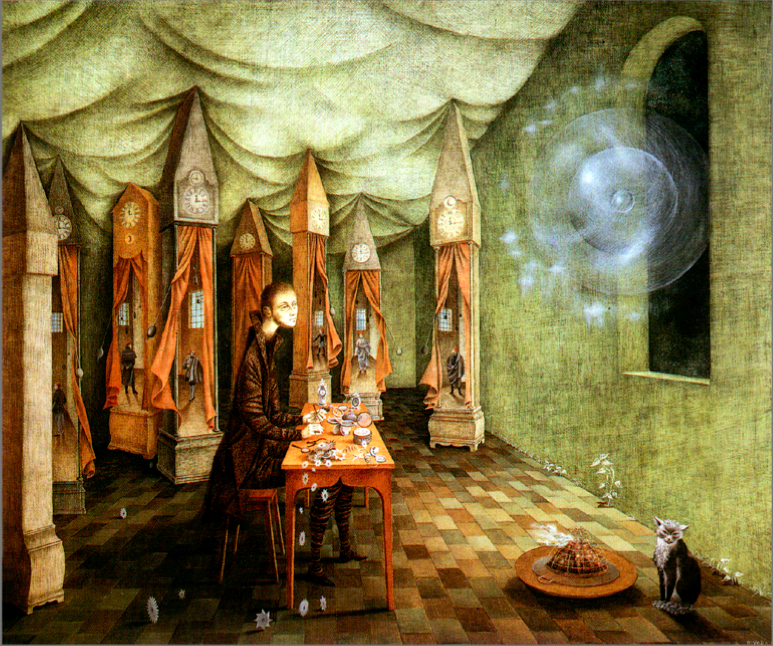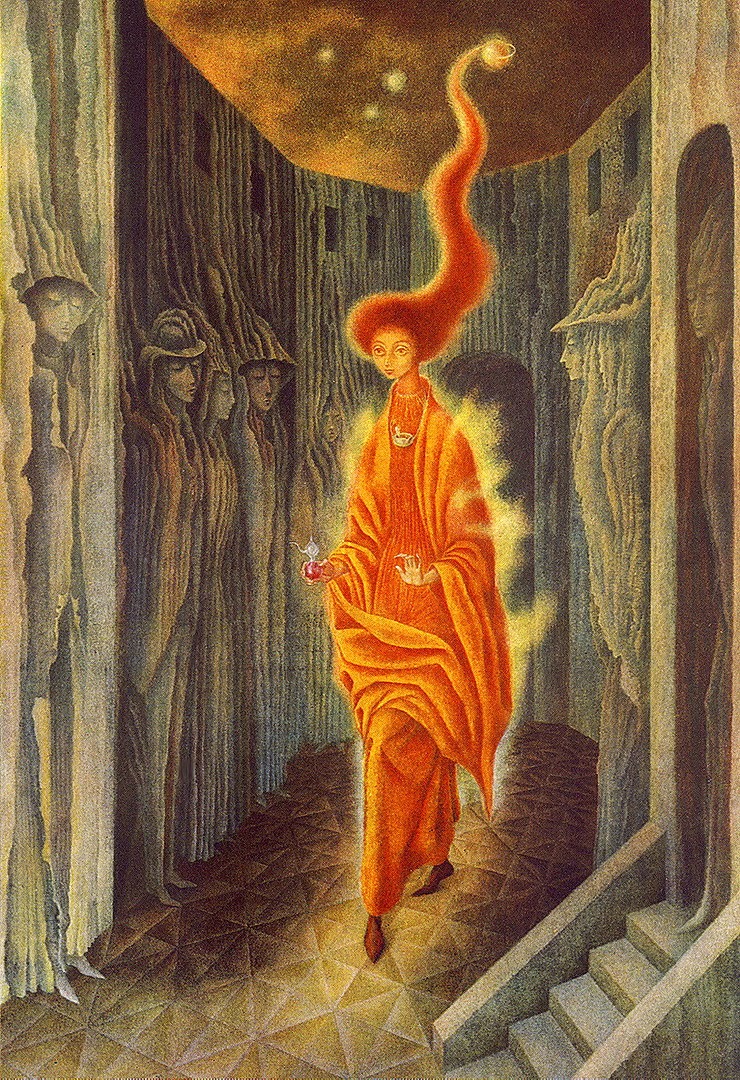 |
| by Yuko Shimizu...how does he see? |
There is a spiritual discipline in Tibetan Buddhism of a certain type of meditation in which one focuses on a being of some sort: a representative being, symbolic, who serves as a companion and as a reminder of certain concepts. This might be a fox, a fox-human hybrid, a monk, a fish-tailed, horse-hooved woman whose purity of heart is stronger than any human weapon. One focuses on this being with such concentration and such intent, that eventually the thought materializes into a physical form. He or she can begin to materialize even when not called upon, and can be seen by others, but it still will not survive long without the focused practice of the meditator. This materialized thoughtform is called a Tulpa.
“The term entered Western literature in 1929, through the explorer Alexandra David-Néel’s “Magic and Mystery in Tibet.” She wrote that Tibetan monks created Tulpas as a spiritual discipline during intense meditation.[...]
Jack, a young man I interviewed, decided to make a Tulpa when he was in college. He set aside an hour and a half each day for this. He’d spend the first 40 minutes or so relaxing and clearing his mind. Then he visualized a fox (he liked foxes). After four weeks, he started to feel the fox’s presence, and to have feelings he thought were the fox’s.
Finally, after a chemistry exam, he felt that she spoke to him. “I heard, clear as day, ‘Well, how did you do?’ ” he recalled. For a while he was intensely involved with her, and said it felt more wonderful than falling in love with a girl.
Then he stopped spending all that time meditating — and the fox went away. It turned out she was fragile. He says she comes back, sometimes unexpectedly, when he practices. She calms him down.
The mere fact that people like Jack find it intuitively possible to have invisible companions who talk back to them supports the claim that the idea of an invisible agent is basic to our psyche. But Jack’s story also makes it clear that experiencing an invisible companion as truly present — especially as an adult — takes work: constant concentration, a state that resembles prayer.”--T.M. Luhrmann
Some say that this is the way to keep God “alive”: through regular meditative practice on the principles of that God, until He or She is accompanying you in your daily life. On a societal level--if, for example, everyone in your neighborhood is doing the same thing, and they all pretty much agree on the principles of the God-- the being could have quite a strong physical existence. In fact, if we were to go back to the story of St. Fevronia, we might say that those who can see the religious processions taking place inside the lake, those who can hear the bells tolling--the ones who are called pure of heart--those are the ones who focus on her story, her spirit, her representation with sufficient intent. When we read the studies--like the gorilla studies-- in neuroscience which describe humans as beings who will only see what their brain thinks is important or relevant to its worldview and understanding of needs, desires and dangers, and we wonder why those perceptive blinders were put on so early in life (around 5 years of age), we could understand it to be a matter of concentration, meditation, intent. A small child has to pay close attention to make out the shapes and colors and humans around him or her, and to understand their intentions and their words. After that small child has ‘figured it out,’ the sense of urgency and focus tends to decrease, beliefs are in place, and when you meet a new person, you make your judgement of who they are and what they represent and what kind of things they’re going to say and what those things will really mean pretty much instantaneously--and what that person actually does or says will be something close to irrelevant as far as changing your mind goes. The same type of neuroscience studies are telling us that we consciously make decisions about 5% of the time--the rest of the time, we’re on autopilot, marching our way through life to a tune we can barely hear.
How many of the religious really pray? How many people will take five minutes out of their day to blank their minds of lists and concerns and plans, and focus on an ideal, however important they may claim that ideal to be?
 |
| by Yuko Shimizu |
Here’s a thought: artists do it. Readers do it. Writers do it. Brand-new lovers do it. Not all of them, of course, but when you are stopped, in your rush to get somewhere or do something, by an image, that is a moment of opportunity. What stopped you about the image? What didn’t fit in your perceptual bias, making you suddenly consciously aware of your surroundings? Don’t discard it and move on! Pay Attention. Maybe it was the colors, maybe a sense of motion, or a sense of suspension; maybe an interaction between the depicted characters struck an emotional chord or a curiosity. What is the story behind the image, and how is it different from the one you usually believe to underly the world’s events and the interactions of the people around you? When you read a book, and you don’t want to put it down to sleep, or use the bathroom, or eat, or go to work, you have sunk into another way of being and seeing. Your brain is experiencing events as if they were occurring in the physical space around you, you are taking in the feelings and behaviors and traumas and excitements as your own (so be careful). This experience offers an opportunity to alter your own perception, to see the world in a slightly different light, and if you were to, for example, when you finish the book, call up a character in your mind and converse with him or her, if you were to really visualize the character--skin-tone, scent, hair-texture, style of dress, voice-print, style of speech--and then spend time with him or her, speak with her, listen to what she has to say, could those interactions change who you are and the world around you? Could you even bring that character into physical being?
 |
| The Unwritten, Cover of Volume One by Yuko Shimizu |
 |
| Cover of The Unwritten, by Yuko Shimizu |
In The Unwritten, Tom Taylor is presented to us as the son of the author of a wildly famous series of books (think Harry Potter) who disappeared under mysterious circumstances. The protagonist of the series, Tommy Taylor, is named after him, and Tom himself goes around to conventions to tell adoring fans about his dad and answer questions and sign things--an existence he detests. He is always trying to point out the distinction between himself and the character, but the idea itself falls on deaf ears. At one of these conventions, a young student stands up and questions his identity as the author’s son. Public opinion swings rapidly and violently, the way it is wont to do, and Tom finds himself hiding from a variety of hateful ex-fans. Soon, his identity is re-established, but not in a way he finds pleasing at all, and not the identity he’d been living before--he goes from reviled to worshiped, from demon to messiah, and all of it through no acts of his own. It’s truly as if he is simply a pawn of a storyline his father put him in before he had a chance to have any say about it--in fact, it’s always been that way, for him, but now events are such that he is forced to do something about it.
What the comic--which is fascinating--begins to explore is the way in which stories shape our society, our ways of thinking, and the very behaviors which we thought were most private and individualistic. The first book introduces a set of characters who shape what stories will be presented to the public by a sinister influence upon the authors. In a way very well-matched to that theme, the comic is wound with stories inside stories, and at one point, Tom’s tale is suspended for a brief foray into history (which soon ties back into his present) via the author and poet Rudyard Kipling.
 |
| Cover of The Unwritten by Yuko Shimizu |
 |
| Cover of The Unwritten by Yuko Shimizu |
His very patriotic poetry, exhorting citizens to give up their youth and lives for empire and the British Way, becomes part of the tale of an author who lost his way and found himself trapped in a terrifying, soul-destroying situation. Crushed, he turns to writing again to find his way out:
 |
| Pages from The Unwritten, Volume One The artwork on these pages is by Mark Carey and Peter Gross, who are also the authors. |
 |
| Pages from The Unwritten, Volume One The artwork on these pages is by Mark Carey and Peter Gross, who are also the authors. |
 |
| Pages from The Unwritten, Volume One The artwork on these pages is by Mark Carey and Peter Gross, who are also the authors. |
The whale in this story is the submerged being that tries to amalgamate all stories so that they support one ideal, but it’s impossible, which is why there will always be ways around and through the most hulking and oppressive walls. I find the idea that music and dancing would be the method, here, to find a rhythm not-in-step with the overpowering pulse of contemporary society, very attractive.
The comic is full of fantastically illustrated and developed ideas of the walls of reality and the possible doorways through them...I recommend it whole-heartedly, and am myself waiting impatiently for the arrival of the second book on my doorstep. The good news (or bad, depending on the state of one’s wallet) is that there are at least 8 books of issues already out.
And one more teaser:
 |
| Pages from The Unwritten, Volume One The artwork on these pages is by Mark Carey and Peter Gross, who are also the authors. |


























